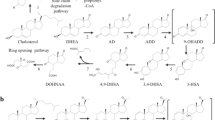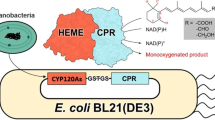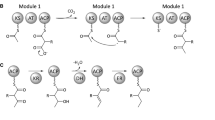Abstract
2A peptide discovered in Picornaviridae is capable of self-cleavage providing an opportunity to carry out synthesis of several proteins using one transcript. Dissociation in the 2A sequence during translation leads to the individual proteins formation. We constructed cDNA including genes of the bovine cholesterol hydroxylase/lyase (CHL) system proteins—cytochrome P450scc (CYP11A1), adrenodoxin (Adx) and adrenodoxin reductase (AdR), that are fused into a single ORF using FMDV 2A nucleotide sequences. The constructed vectors direct the expression of cDNA encoding polyprotein P450scc-2A-Adx-2A-AdR (CHL-2A) in Escherichia coli and Saccharomyces cerevisiae. The induced bacterial cells exhibit a high level of CHL-2A expression, but polyprotein is not cleaved at the FMDV sites. In yeast S. cerevisiae, the discrete proteins P450scc-2A, Adx-2A and AdR are expressed. Moreover, a significant proportion of AdR and Adx is present in a fusion Adx-2A-AdR. Thus, the first 2A linker provides an efficient cleavage of the polyprotein, while the second 2A linker demonstrates lower efficiency. Cholesterol hydroxylase/lyase activity registered in the recombinant yeast cell homogenate indicates that the catalytically active CHL system is present in these cells. Consequently, for the first time the mammalian system of cytochrome P450 has been successfully reconstructed in yeast cells through expressing the self-processing polyprotein.





Similar content being viewed by others
References
Ryan, M. D., King, A. M., & Thomas, G. P. (1991). Cleavage of foot-and-mouth disease virus polyprotein is mediated by residues located within a 19 amino acid sequence. Journal of General Virology, 72, 2727–2732.
Donnelly, M. L. L., Luke, G., Mehrotra, A., Li, X., Hughes, L., Gani, D., et al. (2001). Analysis of the apthovirus 2A/2B polyprotein ‘cleavage’ mechanism indicates not a proteolytic reaction, but a novel translational effect: A putative ribosomal ‘skip’. Journal of General Virology, 82, 1013–1025.
Ryan, M. D., & Drew, J. (1994). Foot-and-mouth disease virus 2A oligopeptide mediated cleavage of an artificial polyprotein. The EMBO Journal, 13, 928–933.
Furler, S., Paterna, J. C., Weibel, M., & Büeler, H. (2001). Recombinant AAV vectors containing the foot and mouth disease virus 2A sequence confer efficient bicistronic gene expression in cultured cells and rat substantia nigra neurons. Gene Therapy, 8, 864–873.
Simmons, A. D., Moskalenko, M., Creson, J., Fang, J., Yi, S., VanRoey, M. J., et al. (2008). Local secretion of anti-CTLA-4 enhances the therapeutic efficacy of a cancer immunotherapy with reduced evidence of systemic autoimmunity. Cancer Immunology, Immunotherapy, 57, 1263–1270.
Kim, J., Lee, S., Li, L., Park, H., Park, J., Lee, K., et al. (2011). High cleavage efficiency of a 2A peptide derived from porcine teschovirus-1 in human cell lines, zebrafish and mice. PLoS ONE, 6, e18556.
Chng, J., Wang, T., Nian, R., Lau, A., Hoi, K. M., Ho, S. C., et al. (2015). Cleavage efficient 2A peptides for high level monoclonal antibody expression in CHO cells. MAbs, 7, 403–412.
Cinti, A., De Giorgi, M., Chisci, E., Arena, C., Galimberti, G., Farina, L., et al. (2015). Simultaneous overexpression of functional human HO-1, E5NT and ENTPD1 protects murine fibroblasts against TNF-α-induced injury in vitro. PLoS ONE, 10, e0141933.
Daniels, R. W., Rossano, A. J., Macleod, G. T., & Ganetzky, B. (2014). Expression of multiple transgenes from a single construct using viral 2A peptides in Drosophila. PLoS ONE, 9, e100637.
Amrani, A. E., Barakate, A., Askari, B. M., Li, X., Roberts, A. G., Ryan, M. D., et al. (2004). Coordinate expression and independent subcellular targeting of multiple proteins from a single transgene. Plant Physiology, 135, 16–24.
Ha, S.-H., Liang, Y. S., Jung, H., Ahn, M.-J., Suh, S.-C., Kweon, S.-J., et al. (2010). Application of two bicistronic systems involving 2A and IRES sequences to the biosynthesis of carotenoids in rice endosperm. Plant Biotechnology Journal, 8, 928–938.
Wang, S., Yao, Q., Tao, J., Qiao, Y., & Zhang, Z. (2007). Co-ordinate expression of glycine betaine synthesis genes linked by the FMDV 2A region in a single open reading frame in Pichia pastoris. Applied Microbiology and Biotechnology, 77, 891–899.
Roongsawang, N., Promdonkoy, P., Wongwanichpokhin, M., Sornlake, W., Puseenam, A., Eurwilaichitr, L., et al. (2010). Coexpression of fungal phytase and xylanase utilizing the cis-acting hydrolase element in Pichia pastoris. FEMS Yeast Research, 10, 909–916.
Sun, Y.-F., Lin, Y., Zhang, J.-H., Zheng, S.-P., Ye, Y.-R., Liang, X.-X., et al. (2012). Double Candida antarctica lipase B co-display on Pichia pastoris cell surface based on a self-processing foot-and-mouth disease virus 2A peptide. Applied Microbiology and Biotechnology, 96, 1539–1550.
Miller, W. L. (2008). Steroidogenic enzymes. Endocrine Development, 13, 1–18.
Sambrook, J., Fritsch, E. F., & Maniatis, T. (1989). Molecular cloning: A laboratory manual (2nd ed.). Cold Spring Harbor, NY: Cold Spring Harbor Laboratory Press.
Rhee, S. K., Icho, T., & Wickner, R. B. (1989). Structure and nuclear localization signal of the SKI3 antiviral protein of Saccharomyces cerevisiae. Yeast, 5, 149–158.
Wada, A., Mathew, P. A., Barnes, H. J., Sanders, D., Estabrook, R. W., & Waterman, M. R. (1991). Expression of functional bovine cholesterol side chain cleavage cytochrome P450 (P450scc) in Escherichia coli. Archives of Biochemistry and Biophysics, 290, 376–380.
Hannemann, F., Virus, C., & Bernhardt, R. (2006). Design of an Escherichia coli system for whole cell mediated steroid synthesis and molecular evolution of steroid hydroxylases. Journal of Biotechnology, 124, 172–181.
Sagara, Y., Takata, Y., Miyata, T., Hara, T., & Horiuchi, T. (1987). Cloning and sequence analysis of adrenodoxin reductase cDNA from bovine adrenal cortex. The Journal of Biochemistry, 102, 1333–1336.
Uhlmann, H., Kraft, R., & Bernhardt, R. (1994). C-terminal region of adrenodoxin affects its structural integrity and determines differences in its electron transfer function to cytochrome P-450. The Journal of biological chemistry, 269, 22557–22564.
Makeeva, D. S., Dovbnya, D. V., Donova, M. V., & Novikova, L. A. (2013). Functional reconstruction of bovine P450scc steroidogenic system in Escherichia coli. American Journal of Molecular Biology, 3, 173–182.
Savelev, A. S., Novikova, L. A., Drutsa, V. L., Isaeva, L. V., Chernogolov, A. A., Usanov, S. A., et al. (1997). Synthesis and some aspects of topogenesis of bovine cytochrome P450scc in yeast. Biochemistry (Moscow), 62, 779–786.
Cullin, C., & Pompon, D. (1988). Synthesis of functional mouse cytochromes P-450 P1 and chimeric P-450 P3-1 in the yeast Saccharomyces cerevisiae. Gene, 65, 203–217.
Nazarov, P. A., Drutsa, V. I., Miller, W. I., Shkumatov, V. M., Luzikov, V. N., & Novikova, L. A. (2003). Formation and functioning of fused cholesterol side-chain cleavage enzymes. DNA and Cell Biology, 22, 243–252.
Akiyoshi-Shibata, M., Sakaki, T., Yabusaki, Y., Murakami, H., & Ohkawa, H. (1991). Expression of bovine adrenodoxin and NADPH-adrenodoxin reductase cDNAs in Saccharomyces cerevisiae. DNA and Cell Biology, 10, 613–621.
Herrmann, J. M., Folsch, H., Neupert, W., & Stuart, R. A. (1994). In D. E. Celis (Ed.), Cell biology handbook, Vol. 1. San Diego, CA: Academic Press, Inc.
Minenko, A. N., Novikova, L. A., Luzikov, V. N., & Kovaleva, I. E. (2008). Import of hybrid forms of CYP11A1 into yeast mitochondria. Biochimica et Biophysica Acta, 1780, 1121–1130.
Laemmli, U. K. (1970). Cleavage of structural proteins during the assembly of the head of bacteriophage T4. Nature, 227, 680–685.
Towbin, H., Staehelin, T., & Gordon, J. (1979). Electrophoretic transfer of proteins from polyacrylamide gels to nitrocellulose sheets: Procedure and some applications. Proceedings of the National Academy of Sciences USA, 76, 4350–4354.
Lowry, O. H., Rosebrough, N. J., Farr, A. L., & Randall, R. J. (1951). Protein measurement with the Folin phenol reagent. The Journal of biological chemistry, 193, 265–270.
Akhrem, A. A., Lapko, V. N., Lapko, A. G., Shkumatov, V. M., & Chashchin, V. L. (1979). Isolation, structural organization and mechanism of action of mitochondrial steroid hydroxylating systems. Acta Biologica et Medica Germanica, 38, 257–273.
Shashkova, T. V., Luzikov, V. N., & Novikova, L. A. (2006). Coexpression of all constituents of the cholesterol hydroxylase/lyase system in Escherichia coli cells. Biochemistry (Moscow), 71, 810–814.
Novikova, L. A., Nazarov, P. A., Saveliev, A. S., Drutsa, V. L., Sergeev, V. N., Miller, W. L., et al. (2000). Interaction of catalytic domains in cytochrome P450scc-adrenodoxin reductase—Adrenodoxin fusion protein imported into yeast mitochondria. Biochemistry (Moscow), 65, 1362–1366.
Vinogradova, A. A., Luzikov, V. N., & Novikova, L. A. (2007). Comparative study of topogenesis of cytochrome P450scc (CYP11A1) and its hybrids with adrenodoxin expressed in Escherichia coli cells. Biochemistry (Moscow), 72, 208–214.
Rothwell, D. G., Crossley, R., Bridgeman, J. S., Sheard, V., Zhang, Y., Sharp, T. V., et al. (2010). Functional expression of secreted proteins from a bicistronic retroviral cassette based on foot-and-mouth disease virus 2A can be position dependent. Human Gene Therapy, 21, 1631–1637.
Donnelly, M. L. L., Gani, D., Flint, M., Monaghan, S., & Ryan, M. D. (1997). The cleavage activities of aphthovirus and cardiovirus 2A proteins. Journal of General Virology, 78, 13–21.
Dechamma, H. J., AshokKumar, C., Nagarajan, G., & Suryanarayana, V. V. (2008). Processing of multimer FMD virus VP1-2A protein expressed in E. coli into monomers. Indian Journal of Experimental Biology, 46, 760–763.
Park, M., Kang, K., Park, S., Kim, Y. S., Ha, S.-H., Lee, S. W., et al. (2008). Expression of serotonin derivative synthetic genes on a single self-processing polypeptide and the production of serotonin derivatives in microbes. Applied Microbiology and Biotechnology, 81, 43–49.
Halpin, C., Cooke, S. E., Barakate, A., El Amrani, A., & Ryan, M. D. (1999). Self-processing 2A-polyproteins—A system for co-ordinate expression of multiple proteins in transgenic plants. The Plant Journal, 17, 453–459.
Szymczak, A., Workman, C., Wang, Y., Vignali, K., Dilioglou, S., Vanin, E., et al. (2004). Correction of multi-gene deficiency in vivo using a single ‘self-cleaving’ 2A peptide-based retroviral vector. Nature Biotechnology, 22, 589–594.
De Felipe, P., & Ryan, M. D. (2004). Targeting of proteins derived from self-processing polyproteins containing multiple signal sequences. Traffic, 5, 616–626.
Chaplin, P. J., Camon, E. B., Villarreal-Ramos, B., Flint, M., Ryan, M. D., & Collins, R. A. (1999). Production of interleukin-12 as a self-processing 2A polypeptide. Journal of Interferon and Cytokine Research, 19, 235–241.
Osborn, M. J., Panoskaltsis-Mortari, A., McElmurry, R. T., Bell, S. K., Vignali, D. A., Ryan, M. D., et al. (2005). A picornaviral 2A-like sequence-based tricistronic vector allowing for high-level therapeutic gene expression coupled to a dual-reporter system. Molecular Therapy, 12, 569–574.
De Felipe, P., Luke, G. A., Hughes, L. E., Gani, D., Halpin, C., & Ryan, M. D. (2006). E unum pluribus: Multiple proteins from a self-processing polyprotein. Trends in Biotechnology, 24, 68–75.
Fang, J., Yi, S., Simmons, A., Tu, G. H., Nguyen, M., Harding, T. C., et al. (2007). An antibody delivery system for regulated expression of therapeutic levels of monoclonal antibodies in vivo. Molecular Therapy, 15, 1153–1159.
Ralley, L., Enfissi, E. M., Misawa, N., Schuch, W., Bramley, P. M., & Fraser, P. D. (2004). Metabolic engineering of ketocarotenoid formation in higher plants. The Plant Journal, 39, 477–486.
Lee, D. S., Lee, K. H., Jung, S., Jo, E. J., Han, K. H., & Bae, H. J. (2012). Synergistic effects of 2A-mediated polyproteins on the production of lignocellulose degradation enzymes in tobacco plants. Journal of Experimental Botany, 63, 4797–4810.
De Felipe, P., Hughes, L. E., Ryan, M. D., & Brown, J. D. (2003). Co-translational, intraribosomal cleavage of polypeptides by the foot-and-mouth disease virus 2A peptide. The Journal of biological chemistry, 278, 11441–11448.
De Felipe, P., Luke, G. A., Brown, J. D., & Ryan, M. D. (2010). Inhibition of 2A-mediated ‘cleavage’ of certain artificial polyproteins bearing N-terminal signal sequences. Biotechnology Journal, 5, 213–223.
Yan, J., Wang, H., Xu, Q., Jain, N., Toxavidis, V., Tigges, J., et al. (2010). Signal sequence is still required in genes downstream of ‘‘autocleaving” 2A peptide for secretary or membrane-anchored expression. Analytical Biochemistry, 399, 144–146.
Neupert, W., & Herrmann, J. M. (2007). Translocation of proteins into mitochondria. Annual Review of Biochemistry, 76, 723–749.
Bohnert, M., Pfanner, N., & van der Laan, M. A. (2007). A dynamic machinery for import of mitochondrial precursor proteins. FEBS Letters, 581, 2802–2810.
Devaux, F., Lelandais, G., Garcia, M., Goussard, S., & Jacq, C. (2010). Posttranscriptional control of mitochondrial biogenesis: Spatio-temporal regulation of the protein import process. FEBS Letters, 584, 4273–4279.
Lesnik, C., Golani-Armon, A., & Arava, Y. (2015). Localized translation near the mitochondrial outer membrane: An update. RNA Biology, 12, 801–809.
Golani-Armon, A., & Arava, Y. (2016). Localization of nuclear-encoded mRNAs to mitochondria outer surface. Biochemistry (Moscow), 81, 1038–1043.
Fujiki, M., & Verner, K. (1993). Coupling of cytosolic protein synthesis and mitochondrial protein import in yeast. Evidence for cotranslational import in vivo. The Journal of biological chemistry, 268, 1914–1920.
Kubeil, C., Yeung, J. C. I., Tuckey, R. C., Rodgers, R. J., & Martin, L. L. (2016). Membrane-mediated protein-protein interactions of cholesterol side-chain cleavage cytochrome P450 with its associated electron transport proteins. ChemPlusChem, 81, 995–1002.
Acknowledgements
This study was supported by RFBR, Grant Number: 15-08-00721. We acknowledge A.I. Luneva for her assistance in analyzing protein expression in yeast cells.
Author information
Authors and Affiliations
Corresponding author
Rights and permissions
About this article
Cite this article
Efimova, V.S., Isaeva, L.V., Makeeva, D.S. et al. Expression of Cholesterol Hydroxylase/Lyase System Proteins in Yeast S. cerevisiae Cells as a Self-Processing Polyprotein. Mol Biotechnol 59, 394–406 (2017). https://doi.org/10.1007/s12033-017-0028-5
Published:
Issue Date:
DOI: https://doi.org/10.1007/s12033-017-0028-5




